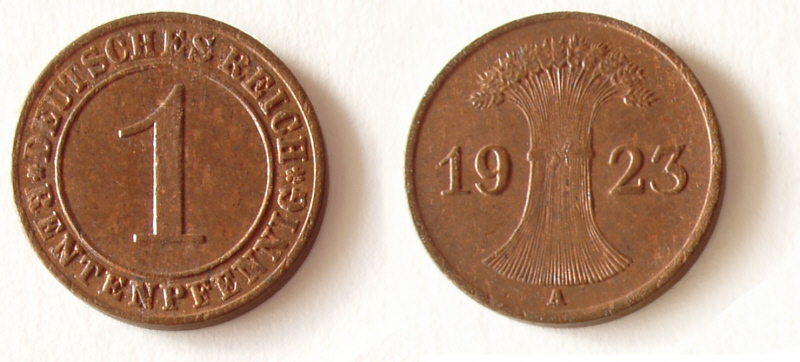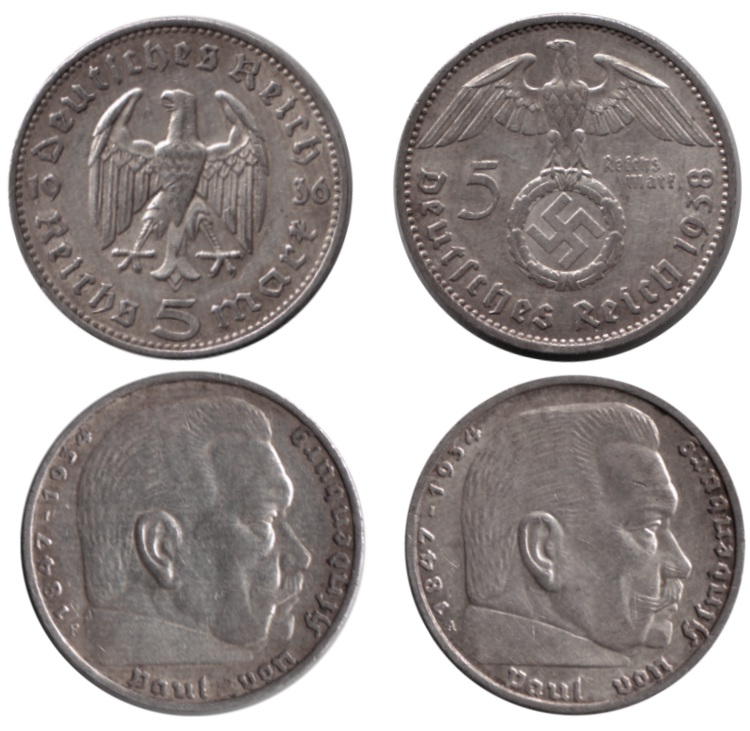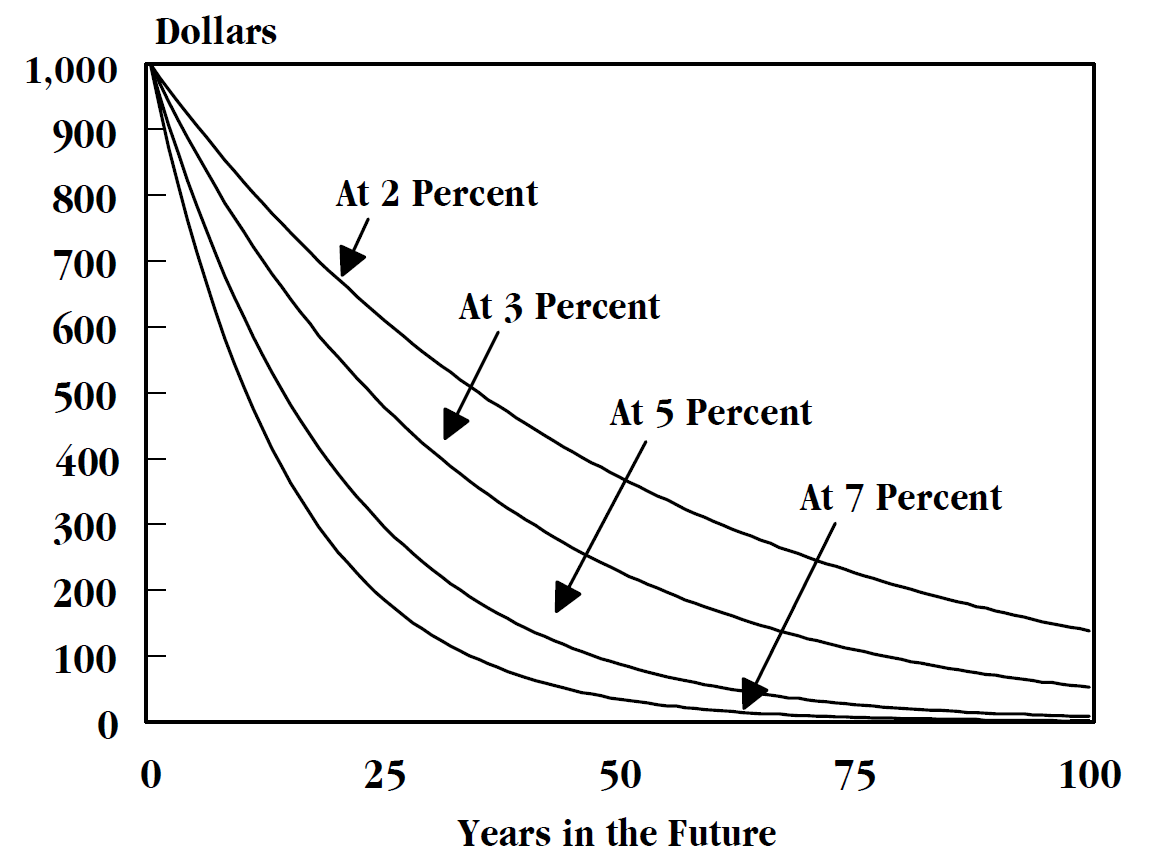|
German Rentenmark
The Rentenmark (; RM) was a currency issued on 15 November 1923 to stop the hyperinflation of 1922 and 1923 in Weimar Germany, after the previously used Papiermark had become almost worthless. It was subdivided into 100 ''Rentenpfennig'' and was replaced in 1924 by the Reichsmark. History After the Occupation of the Ruhr in early 1923 by French and Belgian troops, referred to as the ''Ruhrkampf'', the German government of Wilhelm Cuno reacted by announcing a policy of passive resistance. This caused the regional economy of the Ruhr, the industrial heartland of Germany, to almost stop. The occupation authorities reacted to strikes and sabotage with arrests and deportations. Those displaced and left without income by the ''Ruhrkampf'' and their families fell back on public income support. Tax revenues plunged as economic activity slowed. The government covered its need for funds mainly by printing money. As a result, inflation spiked and the Papiermark went into freefall on ... [...More Info...] [...Related Items...] OR: [Wikipedia] [Google] [Baidu] |
Pfennig
The pfennig (; . 'pfennigs' or 'pfennige' ; currency symbol, symbol pf or ₰) or penny is a former Germany, German coin or note, which was an official currency from the 9th century until the introduction of the euro in 2002. While a valuable coin during the Middle Ages, it lost its value through the years and was the minor coin of the Mark (money), Mark currencies in the German Reich, West Germany and East Germany, and the German reunification, reunified Germany until the introduction of the euro. Pfennig was also the name of the subunit of the Danzig mark (1922–1923) and the Danzig gulden (1923–1939) in the Free City of Danzig (modern Gdańsk, Poland). Overview Name The word ''Pfennig'' (replacing the ''denarius'' or ''denarius'' as a low-denomination silver coin) can be traced back to the 8th century and also became known as the ''Penning'', ''Panni(n)g '', ''Pfenni(n)c'', ''Pfending'' and by other names, e.g. in Prussia until 1873, ''Pfenning''. The ''-ing''- ... [...More Info...] [...Related Items...] OR: [Wikipedia] [Google] [Baidu] |
Rentenbank
The Deutsche Rentenbank was a bank established in Germany by a regulation of 15 October 1923 as a state-owned monetary authority authorised to issue Rentenmark currency notes following the collapse of the private Reichsbank's Papiermark currency. The Rentenbank reserves consisted of mortgages against leading industrial properties and the German public accepted these reserves as being sound. This meant that the monetary crisis caused by the public's lack of confidence in the currency of the Reichsbank waned and the hyperinflation In economics, hyperinflation is a very high and typically accelerating inflation. It quickly erodes the real versus nominal value (economics), real value of the local currency, as the prices of all goods increase. This causes people to minimiz ... ceased. The Rentenmarks continued to be accepted as currency in Germany until 1947. References External links * Act creating the Deutschen RentenbanReichsgesetzblatt Teil I, 17 October 1923* Banks ... [...More Info...] [...Related Items...] OR: [Wikipedia] [Google] [Baidu] |
Third Reich
Nazi Germany, officially known as the German Reich and later the Greater German Reich, was the German state between 1933 and 1945, when Adolf Hitler and the Nazi Party controlled the country, transforming it into a totalitarian dictatorship. The Third Reich, meaning "Third Realm" or "Third Empire", referred to the Nazi claim that Nazi Germany was the successor to the earlier Holy Roman Empire (800–1806) and German Empire (1871–1918). The Third Reich, which the Nazis referred to as the Thousand-Year Reich, ended in May 1945, after 12 years, when the Allies defeated Germany and entered the capital, Berlin, ending World War II in Europe. After Hitler was appointed Chancellor of Germany in 1933, the Nazi Party began to eliminate political opposition and consolidate power. A 1934 German referendum confirmed Hitler as sole '' Führer'' (leader). Power was centralised in Hitler's person, and his word became the highest law. The government was not a coordinated, coopera ... [...More Info...] [...Related Items...] OR: [Wikipedia] [Google] [Baidu] |
Weimar Republic
The Weimar Republic, officially known as the German Reich, was the German Reich, German state from 1918 to 1933, during which it was a constitutional republic for the first time in history; hence it is also referred to, and unofficially proclaimed itself, as the German Republic. The period's informal name is derived from the city of Weimar, which hosted the constituent assembly that established its government. In English, the republic was usually simply called "Germany", with "Weimar Republic" (a term introduced by Adolf Hitler in 1929) not commonly used until the 1930s. The Weimar Republic had a semi-presidential system. Toward the end of the First World War (1914–1918), Germany was exhausted and suing for peace, sued for peace in desperate circumstances. Awareness of imminent defeat sparked a German Revolution of 1918–1919, revolution, Abdication of Wilhelm II, the abdication of Kaiser Wilhelm II, the proclamation of the Weimar Republic on 9 November 1918, and formal cessa ... [...More Info...] [...Related Items...] OR: [Wikipedia] [Google] [Baidu] |
Bronze
Bronze is an alloy consisting primarily of copper, commonly with about 12–12.5% tin and often with the addition of other metals (including aluminium, manganese, nickel, or zinc) and sometimes non-metals (such as phosphorus) or metalloids (such as arsenic or silicon). These additions produce a range of alloys some of which are harder than copper alone or have other useful properties, such as strength, ductility, or machinability. The archaeological period during which bronze was the hardest metal in widespread use is known as the Bronze Age. The beginning of the Bronze Age in western Eurasia is conventionally dated to the mid-4th millennium BCE (~3500 BCE), and to the early 2nd millennium BCE in China; elsewhere it gradually spread across regions. The Bronze Age was followed by the Iron Age, which started about 1300 BCE and reaching most of Eurasia by about 500 BCE, although bronze continued to be much more widely used than it is in modern times. Because historica ... [...More Info...] [...Related Items...] OR: [Wikipedia] [Google] [Baidu] |
10Rentenpf
1 (one, unit, unity) is a number, numeral, and glyph. It is the first and smallest positive integer of the infinite sequence of natural numbers. This fundamental property has led to its unique uses in other fields, ranging from science to sports, where it commonly denotes the first, leading, or top thing in a group. 1 is the unit of counting or measurement, a determiner for singular nouns, and a gender-neutral pronoun. Historically, the representation of 1 evolved from ancient Sumerian and Babylonian symbols to the modern Arabic numeral. In mathematics, 1 is the multiplicative identity, meaning that any number multiplied by 1 equals the same number. 1 is by convention not considered a prime number. In digital technology, 1 represents the "on" state in binary code, the foundation of computing. Philosophically, 1 symbolizes the ultimate reality or source of existence in various traditions. In mathematics The number 1 is the first natural number after 0. Each natural number, ... [...More Info...] [...Related Items...] OR: [Wikipedia] [Google] [Baidu] |
1 Rentenpfennig 1923
1 (one, unit, unity) is a number, numeral, and glyph. It is the first and smallest positive integer of the infinite sequence of natural numbers. This fundamental property has led to its unique uses in other fields, ranging from science to sports, where it commonly denotes the first, leading, or top thing in a group. 1 is the unit of counting or measurement, a determiner for singular nouns, and a gender-neutral pronoun. Historically, the representation of 1 evolved from ancient Sumerian and Babylonian symbols to the modern Arabic numeral. In mathematics, 1 is the multiplicative identity, meaning that any number multiplied by 1 equals the same number. 1 is by convention not considered a prime number. In digital technology, 1 represents the "on" state in binary code, the foundation of computing. Philosophically, 1 symbolizes the ultimate reality or source of existence in various traditions. In mathematics The number 1 is the first natural number after 0. Each natural number, ... [...More Info...] [...Related Items...] OR: [Wikipedia] [Google] [Baidu] |
Dawes Plan
The Dawes Plan temporarily resolved the issue of the reparations that Germany owed to the Allies of World War I. Enacted in 1924, it ended the crisis in European diplomacy that occurred after French and Belgian troops occupied the Ruhr in response to Germany's failure to meet its reparations obligations. The Plan set up a staggered schedule for Germany's payment of war reparations, provided for a large loan to stabilise the German currency and ended the occupation of the Ruhr. It resulted in a brief period of economic recovery in the second half of the 1920s, although it came at the price of a heavy reliance on foreign capital. The Dawes Plan was superseded by the Young Plan in 1929. Because the Plan resolved a serious international crisis, the American Charles G. Dawes, who headed the group that developed it, received the Nobel Peace Prize in 1925. Background At the end of World War I, the Allied Powers included in the Treaty of Versailles a plan for the reparations ... [...More Info...] [...Related Items...] OR: [Wikipedia] [Google] [Baidu] |
German Reichsmark
The (; sign: ℛ︁ℳ︁; abbreviation: RM) was the currency of Germany from 1924 until the fall of Nazi Germany in 1945, and in the American, British and French occupied zones of Germany, until 20 June 1948. The Reichsmark was then replaced by the Deutsche Mark, to become the currency of West Germany and then all of Germany after the 1990 reunification. The Reichsmark was used in the Soviet occupation zone of Germany until 23 June 1948, where it was replaced by the East German mark. The Reichsmark was subdivided into 100 (Rpf or ℛ︁₰). The Mark is an ancient Germanic weight measure, traditionally a half pound, later used for several coins; (''realm'' in English) comes from the official name for the German state from 1871 to 1945, . History The Reichsmark was introduced in 1924 as a permanent replacement for the ''Papiermark''. This was necessary due to the 1920s German inflation which had reached its peak in 1923. The exchange rate between the old ''Papiermark'' an ... [...More Info...] [...Related Items...] OR: [Wikipedia] [Google] [Baidu] |
Discounting
In finance, discounting is a mechanism in which a debtor obtains the right to delay payments to a creditor, for a defined period of time, in exchange for a charge or fee.See "Time Value", "Discount", "Discount Yield", "Compound Interest", "Efficient Market", "Market Value" and "Opportunity Cost" in Downes, J. and Goodman, J. E. ''Dictionary of Finance and Investment Terms'', Baron's Financial Guides, 2003. Essentially, the party that owes money in the present purchases the right to delay the payment until some future date.See "Discount", "Compound Interest", "Efficient Markets Hypothesis", "Efficient Resource Allocation", "Pareto-Optimality", "Price", "Price Mechanism" and "Efficient Market" in Black, John, ''Oxford Dictionary of Economics'', Oxford University Press, 2002. This Financial transaction, transaction is based on the fact that most people prefer current interest to delayed interest because of Mortality salience, mortality effects, impatience effects, and Motivational sa ... [...More Info...] [...Related Items...] OR: [Wikipedia] [Google] [Baidu] |
Legal Tender
Legal tender is a form of money that Standard of deferred payment, courts of law are required to recognize as satisfactory payment in court for any monetary debt. Each jurisdiction determines what is legal tender, but essentially it is anything which, when offered ("tendered") in payment of a debt, extinguishes the debt. There is no obligation on the creditor to accept the tendered payment, but the act of tendering the payment in legal tender discharges the debt. It is generally only mandatory to recognize the payment of legal tender in the discharge of a monetary debt from a debtor to a creditor. Sellers offering to enter into contractual relationship, such as a contract for the sale of goods, do not need to accept legal tender and may instead contractually require payment using electronic methods, foreign currencies or any other legally recognized object of value. Coins and banknotes are usually defined as legal tender in many countries, but personal cheque, checks, credit c ... [...More Info...] [...Related Items...] OR: [Wikipedia] [Google] [Baidu] |




